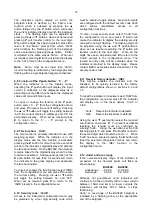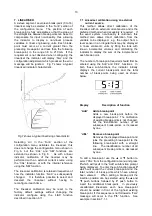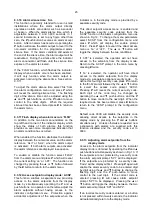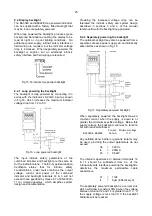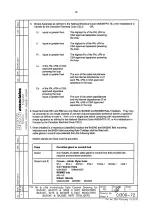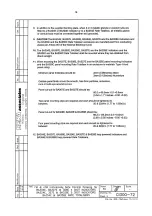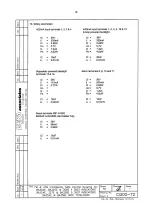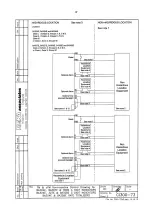
23
9.3.10 Alarm silence time: SiL
This function is primarily intended for use in small
installations where the alarm output directly
operates an alarm annunciator such as a sounder
or beacon. When the alarm silence time, which is
adjustable between 0 and 3600 seconds in 1
second increments, is set to any figure other than
zero, the
P
push-button becomes an alarm accept
button. After an alarm has occurred, operating the
P
button will cause the alarm output to revert to the
non-alarm condition for the programmed alarm
silence time. If the alarm condition still exists at
the end of the silence time, the alarm output will be
reactivated. During the silence time the indicator
alarm annunciator will flash until the silence time
expires or the alarm is cleared.
If the ‘FLSH’ function, which flashes the indicator
display when an alarm occurs has been enabled,
it will only function when the alarm output is
activated, not during the silence time. See section
9.3.11
To adjust the alarm silence time select 'SiL' from
the alarm configuration menu and press
P
which
will reveal the existing silence time. The flashing
digit of the silence time can be adjusted using the
▲
and
▼
push-buttons, and the
P
button to move
control to the other digits. When the required
silence time has been entered press
E
to return to
the alarm menu.
9.3.11 Flash display when alarm occurs
‘FLSH’
In addition to the two alarm annunciators on the
top left hand corner of the indicator display which
show the status of both alarms, this function
provides an even more conspicuous indication that
an alarm condition has occurred.
When enabled, the function alternates the indicator
display between the numerical value and the alarm
reference, ‘ALr1’ or ‘ALr2’, when the alarm output
is activated. If both alarm outputs are activated,
the alarm references are displayed in sequence.
To enable or disable the function select 'FLSH'
from the alarm menu and press
P
which will reveal
the current setting ‘on’ or ‘oFF’. The function can
changed by pressing the
▲
or
▼
button followed
by the
E
button to return to the alarm menu.
9.3.12 Access setpoint in display mode: ACSP
This function enables a separate menu providing
access to the alarm setpoints from the display
mode by simultaneously operating the
P
and
▲
push-buttons. An operator can therefore adjust the
alarm setpoints without having access to the
indicator configuration menu. Protection against
accidental adjustment of the setpoints when the
indicator is in the display mode is provided by a
separate security code.
This direct setpoint access menu is enabled and
the separate security code entered from the
'ACSP' function in the alarm configuration menu as
shown in Fig 12. To change the menu parameters
select 'ACSP' from the configuration menu and
press
P
which will display the enable prompt
'EnbL'. Press
P
again to reveal if the direct access
menu is 'on' or 'oFF'. The
▲
or
▼
button will
toggle the display between the two conditions.
If 'oFF' is selected, the operator will not have
access to the setpoints from the display mode.
Return to the 'ACSP' prompt in the main menu by
pressing
E
twice.
If 'on' is selected, the operator will have direct
access to the alarm setpoints from the display
mode via a separate optional security code. To
define this four digit security code press
P
to return
to the 'Enbl' prompt followed by the
▲
or
▼
button
to select the access code prompt 'ACCd'.
Pressing
P
will reveal the current security code.
Each digit of the code may be changed by
operating the
▲
and
▼
push-buttons, and the
P
button to move control to the next digit. When the
required code has been entered, press
E
twice to
return to the 'ACSP' prompt in the configuration
menu.
Default code 0000 will disable the security code
allowing direct access to the setpoints in the
display mode by pressing the
P
and
▲
buttons
simultaneously. Unless otherwise requested new
instruments with alarms are supplied with this
function disabled and the security code set to
0000.
9.3.13 Adjusting alarm setpoints from the
display mode
Access to the alarm setpoints from the indicator
display mode is obtained by operating the
P
and
▲
push-buttons simultaneously as shown in Fig 13. If
the setpoints are not protected by a security code
the alarm setpoint prompt 'SP1' will be displayed.
If the setpoints are protected by a security code,
'Code' will be displayed first. Pressing
P
again will
enable the alarm security code to be entered digit
by digit using the
▲
and
▼
buttons to change the
flashing digit, and the
P
push-button to move
control to the next digit. If the correct code is
entered pressing
E
will cause alarm setpoint
prompt 'SP1' to be displayed. Pressing the
▲
or
▼
button will toggle the display between the two
alarm setpoint prompts 'SP1' and 'SP2'.
If an incorrect security code is entered, or a button
is not pressed within twenty seconds, the indicator
will automatically return to the display mode.




